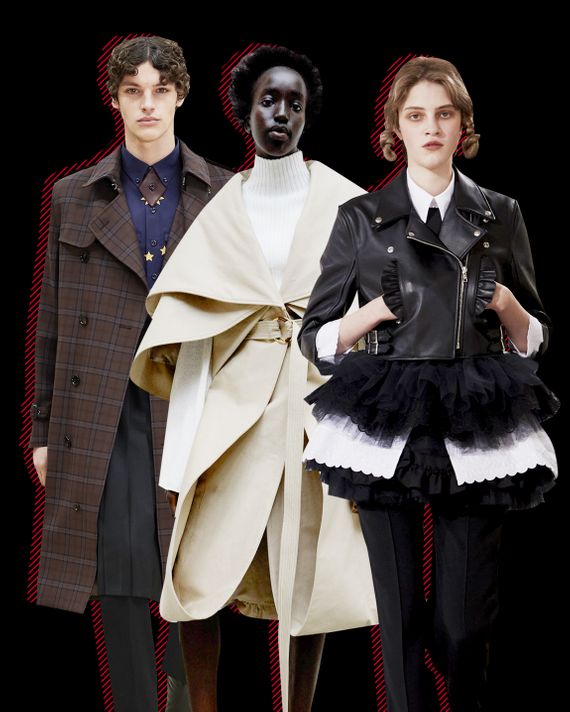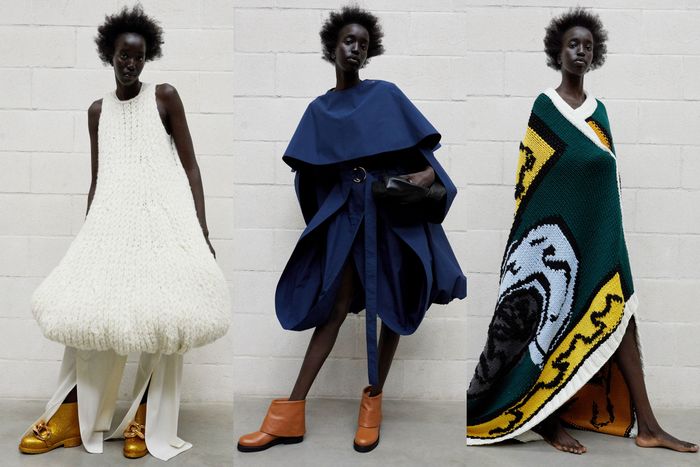
London designers this season faced challenges from both the pandemic and Brexit. Still, there were some extraordinary displays of imagination, beginning with Jonathan Anderson. Here are four inspiring minds.
A Display of Strength From JW Anderson
In lieu of a runway show or indeed anything resembling a fashion format, Anderson again collaborated with the photographer Juergen Teller for a series of poster-printed images of his fall women’s line, released this morning, along with an explanatory video. Anderson and Teller also worked with the well-known ceramic artist Dame Magdalene Odundo and a relatively new artist, Mississippi-born Shawanda Corbett, who does ceramics as well as performance pieces, and who was born with one arm and without legs. The two women contributed artwork to six limited-edition blanket designs that Anderson produced in Scotland. And they appear in Teller’s sharply edited portfolio.
This presentation works so well for the reason given in Anderson’s video: “It’s probably the most personal project I’ve ever done.” That’s saying a lot from a creative director who is very aware of branding, who’s also behind the luxury label Loewe. Not only does Anderson succeed in relating his aesthetic forms to sculpture, but he also connects them to the human body in a way that is no less simple and direct. That’s what I loved most about this collection — it’s magisterial directness.
Which is not to say Anderson didn’t take risks. He offered only a few shapes: elongated knit or silk dresses swelling toward the hem; gorgeous coats in khaki or navy cotton drill, with segments above and below the belt that seem to unfold; and classic shirts and slacks in abstract prints. Additionally, there are his fat gold-buckled shoes — now as gold-glitter ankle boots — and a white pom-pom bag that’s the size of a beach ball.
But, in way or another, the presentation was about strength — in form and artistic character.
A Confident Showing at Burberry
Surely I am not the only person who looked at Riccardo Tisci’s stocky models at Burberry, in their earthy plaids, bullion-fringed shirts, and skintight black leather boots, and imagined them flinging themselves across a muddy English field after a little rugby ball. It’s not that Tisci’s collection had much to do with the sporting scene; in fact, it was aimed at one of Britain’s periodic back-to-nature movements, usually following a war. For Tisci, the pandemic has felt like a war.
But this is Burberry with an altogether new edge, based on a stockier silhouette. That’s what led me to picture athletic Brits and Scots flopping in the mud. It’s muscular, brave, and ironic. Tisci has filched the bullion fringe from a drawing room and the coat-of-arms pattern from a peer’s lodge hall, and channeled them into geo-patterned tunic shirts, intarsia knits. The pleated skirts, pictured here in copper animal-print mohair, could not have been fresher. Tisci also broke down the classic form of the trench coat, now in smooth camel’s hair, with fewer surface details, and he subverted the duffle coat with rough faux–silver fox, an almost primitive-looking material he also used for long, layered vests.
In cut and proportion, this collection seems more in line with Tisci’s work at Givenchy, and maybe that’s why it looks so confident. But he also, finally, has a better grip on English traditions, which are largely country traditions. Indeed, the masculine suit as we know it has its roots in rural garb, later buffed up by the finest tailors. I don’t know if that was behind Tisci’s nature theme, but the results were superb. Now let’s hope he can do the same for Burberry women’s.
Head Trips From Stephen Jones
Sometime last fall I began going to bed with the thought: Where shall I go tonight? London? Berlin, to see my friend Klaus? Usually I went to London; it was more familiar. I’d start in St. James and wend my way up to Soho and dinner at Quo Vadis. I’m sure many people have had travel fantasies to break the tedium of isolation, to escape lives that have become bewildering to them. Not only am I spiffed up in these dreams, out of my farmer clothes and into my best Paris coat, but I am smiling and, completely out of character, I am wearing the most beautiful hat.
All this was on my mind — the hat, the added height and flirting which accompanied it — when I called Stephen Jones, the acclaimed English milliner. Jones had just posted to his Instagram a wonderful 15-minute film of his fall collection, “French Kiss.” Whether or not you’re a hat person, I urge everyone to watch it. It delves into the creative process and shows how hats are made, from concept and sketches to blocking and fitting. It’s something that Jones, who also makes headgear for Dior, Thom Browne, Comme des Garçons, and Marc Jacobs, has never done before — and he does it with great modesty and charm. Of course the timing of “French Kiss” is significant: Many of us long to get out of ourselves and feel joy. That’s certainly one function of fashion.
“I think so much of what we have been wearing is about protection and keeping people away,” Jones said from Antwerp, where he was dropping off some hats at a museum before going to Paris. “Maybe the flip side of that will be about attraction. It’s maybe as simple as that. You may still need to wear a mask, but you can show your shoulders. A hat really encapsulates that feeling, because it’s not really a necessary thing.”
So much of the kind of fashion that Jones understands is rooted in the historical relationship between France and England. There’s French chic — expressed in black and a touch of boudoir pink; and there’s English eccentricity and irony — expressed in a gorgeous, modified Napoleon bicorne with a deep-red cockade, and a miniature top hat with a pair of lips and probing tongues, formed in fabric, on top. As Jones says in the film, his aim was “to create a hat for a woman to make love in.” There are actually three such styles, as well as a blindfold in net.
Another thing that a hat encapsulates is effort — the effort to invent but also to dress up. For most of us in the past year, there’s been very little effort to spare. And yet, looking at the fall fashion now coming out of Europe — Fendi’s glamour, Prada’s fabulous coats — it may be the thing we most crave. To feel alive again. To connect. Isn’t that really the point of my flirtatious London head trips?
“It’s so true, because we don’t have those kinds of relationships with people now,” he said. “Everything is so guarded — it has to be. But actually the idea of flirting with people, it’s a state of being. I’m going to have fun, I’m going to be fun.”
Since summer is a major hat season in England, between sporting events and weddings, and since many couples put off weddings last year, I wondered if Jones expects a deluge of orders as the country reopens.
He does. Inquiries have already started.
“I think anything before mid-May is going to be a lot of Zoom calls, and then all hell is going to break loose. On the seventeenth of May, I think.” Jones gave a big laugh. “Form a line in the street, please, girls.”
A New Direction for Simone Rocha
The narrative thread of Simone Rocha’s collection is easy enough to see: It begins with the hard, protective shell of black leather jackets, with escaping bits of tulle, and gradually exposes “the fragility beneath,” as she put it the other day. The latter portion of her lineup is dominated by wispy or frothy dresses in solid pink, white, or black, all signature Rocha, trimmed with roses and hanks of fabric. “By the end, the only leather left holding things together are these sort of harness pieces,” she told me.
True, but perhaps Rocha has buried the lead. This collection seemed a real departure for her — more varied in shapes and silhouette. She has not shown this much leg or waist in a while, nor so much punk spirit, thanks to the combination of biker leather, mini crinis, and new-looking combat boots with a sculptural platform. And she caused this pleasant creative disruption during a lockdown.
“I’m thrilled to put it out there, actually,” Rocha said. “I feel very lucky to be able to translate everything you go through.”
For me, the key looks were No. 9 and No. 10. The first (triptych above, look on the right) gave ballast to her trademark femininity — cotton roses spilling down the front and side of a crisp white cotton shirt that she paired with a powdery-beige tulle skirt. In reality, some of those roses are part of a “bustle” belt that was turned round to the front. The other outfit, No. 10 (top of post, look on the right), consists of a cropped leather jacket — she wanted to suggest an empire silhouette — with three pieces stuffed under the jacket: a white poplin shirt with an embroidered hem, a georgette top with an attached crinoline, and a micro tutu.
Add a pair of black boy trousers, and you have a look for fall parading. The trimmed shirt is a nice naïve touch, perhaps reflecting the transition from lockdown to reemerging. “Actually,” said Rocha, “white cotton poplin against leather is amazing!”









